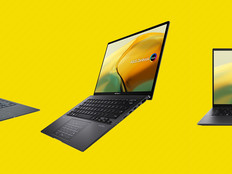Why Wearables Will Become Must-Have Technology
It’s not enough to have a small, light, always-connected piece of technology in your pocket anymore. Now, we must wear it.
Google Glass has been the wearable technology topping headlines lately, but last year it was the Pebble watch. The demand for a computerlike device that can be worn on the wrist was so strong that the company exceeded its $100,000 goal on Kickstarter and ended up with $10 million.
Following in Pebble’s footsteps, fitness-focused wearables have exploded onto the scene. For example, the Fitbit, which is something like a cross between a pedometer and a smartphone, is being clipped onto hundreds of thousands of runners, walkers, and calorie counters of all types (and, oh, how they love to sync their step totals to Facebook).
Don't let the backlash against Google Glass fool you — even if “obnoxious” early adopters are referred to as “Glassholes” — wearable tech is in everyone’s future. Actually, it has also been in our past. Fans of comics legend Dick Tracy drooled over his two-way wrist radio from the moment it appeared in the funny papers in the 1946. So you might say that the Pebble watch was a long time coming.
The Promise of Tech That You Wear
If you're old enough, you remember a time when there was one telephone per household, and it was usually attached to the wall in the kitchen. Many people who grew up in those households now carry a smartphone that has more processing power than much of the technology that NASA used to take us to the moon. With that much intelligence powering “personal area networks,” you can bet wearable tech is a growth industry.
As the Google Glass technology advances, it could become a smartphone app synced via Bluetooth to a thin film display over one lens of your eyeglasses or sunglasses. Do you wear contacts? Researchers are already working on displaying images directly on contact lenses.
The advantages of an augmented experience like this are countless. It’s information that is so close to us, it almost feels like an extension of ourselves.
But an increasing number of vocal privacy groups, especially in Europe, are demanding to opt-out of a world filled with surveillance cameras on buildings and people’s glasses. Tech blogger Robert Scoble’s decision to walk into public restrooms while wearing his Google Glass probably didn’t help ease the fears of the antiwearables crowd, either.
If we've learned anything from the rise of the social media age, it's that people will gladly trade many privacies for convenience. So don’t be surprised if the legal challenges to wearable technology disappear as completely as those phones bolted to the kitchen wall have.
Taking the wearable tech idea one step further, the Syfy’s show Continuum features a police officer from 2077, who gets thrown back to the present day while chasing terrorists. Her form-fitting body suit (this is TV, remember) is a full-fledged supercomputer, including data processors, recording tools, Internet communications and military-grade weaponry.
While it’s fun to imagine how limited the technology of today will feel in comparison with whatever we dream up in 2077, I’m pretty sure that we’ll soon adopt a motto that will last well into that future.
Wearable tech: Don't leave home without it.







